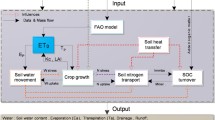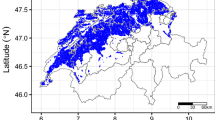Abstract
In the arid and semi-arid environments where the rainfall is limited and variable, fallow period soil moisture conservation using stubble is one of the ways of increasing the soil moisture required for crop sowing and development. However, the effectiveness of moisture conservation using stubble depends on the paddock management, soil water content, and rainfall characteristics. To assess the effect of stubble rate and amount of rainfall on the soil moisture conservation, a two-season field experiment was conducted using four stubble rates (0, 2, 4, 6 t/ha) and two water supply amounts. The soil water dynamics was also analysed using a validated Agricultural Production System Simulator (APSIM). In the relatively wet summer season with a high initial soil water content, the amount of water stored in the 2, 4, and 6 t/ha stubble rate treatment plots was higher than that of the bare plots by 10.4, 15.9, and 17.8 mm, respectively. However, in the summer season with a relatively high amount of in-season water input and low initial soil water content, the soil water storage was increased by 29.4, 35.6, and 43.0 mm, respectively. Comparing the results of the two seasons, the highest increase was observed for the 2 t/ha stubble rate. The amount of conserved soil moisture was found to be the highest when the soil profile water content at the start of the summer-fallow period is low and the amount of rain during the summer season is high. The good agreement between the measured and APSIM-simulated soil water contents (R 2 = 0.812), indicates that the model can be used to assess the soil water dynamics under a fallow condition. The APSIM-simulated soil water balance using the weather data of the past 100 years indicated that in a year with low start-of-fallow period soil water content, a 6 t/ha stubble rate can increase the end-of-fallow period soil moisture by up to 60 %.




Similar content being viewed by others
References
Anwar MR, O’Leary GL, Rab MA, Fisher PD, Armstrong RD (2009) Advances in precision agriculture in south-eastern Australia. V. Effect of seasonal conditions on wheat and barley yield response to applied nitrogen across management zones. Crop Past Sci 60:901–911
ApSoil (2013) A database of soil characteristics. http://www.apsim.info/Wiki/APSoil.ashx
Cornish PE (1987) Effects of wheat residues and tillage on the water balance of a red earth soil. In: Proceedings of the 4th Australian Agronomy Conference, Australian society of agronomy, La Trobe University, Melbourne, p. 294
Cornish PS, Lymbery JR (1986) Coping with too much stubble: target stubble levels and wide rows. In: JE Pratley, PS Cornish (eds) “Recent advances in weed and crop residue management”, Riverina-Murray Institute of Higher Education, Wagga Wagga, NSW, 27 Feb 1986, pp. 36–38
Cutforth HW, McConkey BG, Ulrich D, Miller PR, Angadi SV (2002) Yield and water use efficiency of pulses seeded directly into standing stubble in the semi-arid Canadian prairie. Can J Plant Sci 82:681–686
Dhammapala R, Claiborn C, Corkill J, Gullett B (2006) Particulate emissions from wheat and Kentucky bluegrass stubble burning in eastern Washington and northern Idaho. Atmos Environ 40:1007–1015
Felton WL, Freebrain DM, Fettell NS, Thomas J (1987) Crop residue management. In: Cornish PS, Pratley JE (eds) Tillage: new directions for Australian agriculture. Inkarta Press, Sydney, pp 179–193
Freebairn DM, Silburn DM (2004) Soil conservation in Australia’s semi-arid tropics: pathways to success, and new challenges. In: SR Raine, AJW Biggs, NW Menzies, DM Freebairn, PE Tolmie (eds)“Conserving soil and water for society: sharing solutions. Proceedings of the 13th International Soil Conservation Organisation Conference”, Australian Society of Soil Science Incorporated/International Erosion Control Association, pp. 416
Gregory PJ, Simmonds LP, Pilbeam CJ (2000) Soil type, climatic regime, and the response of water use efficiency to crop management. Agron J 92:814–820
Incerti M, Sale PWG, O’Leary GJ (1993) Cropping practices in the Victorian Mallee: 1. Effect of direct drilling and stubble retention on the water economy and yield of wheat. Aust J Exp Agr 33:877–883
Keating BA, Carberry PS, Hammer GL, Probert ME, Robertson MJ, Holzworth D, Huth NI, Hargreaves JNG et al (2003) An overview of APSIM, a model designed for farming systems simulation. Eur J Agron 18:267–288
Kirkegaard JA (1995) A review of trends in wheat yield responses to conservation cropping in Australia. Aust J Exp Agr 35:835–848
Kirkegaard JA, Howe GN, Simpfendorfer S, Angus JF, Gardner PA, Hutchinson P (2001) Poor wheat yield response to conservation cropping—causes and consequences during 10 years of the Harden Tillage Trial. In: “Proceedings Australian Agronomy Conference”. Australian Society of Agronomy
Lawrence PA, Radford BJ, Thomas GA, Sinclair DP, Key AJ (1994) Effect of tillage practices on wheat performance in a semi-arid environment. Soil Till Res 28:347–364
Loague K, Green RE (1991) Statistical and graphical methods for evaluating solute transport models: overview and application. J Contam Hydrol 7:57–73
Marley JM, Littler JW (1989) Winter cereal production on the Darling Downs—an 11 year study of fallowing practices. Aust J Exp Agr 29:807–827
Mckenzie N, Jacquier D, Isbell R, Brown K (2004) Australian soils and landscapes: an illustrated compendium. CSIRO publishing, Collingwood
Monzon JP, Sadras VO, Andrade FH (2006) Fallow soil evaporation and water storage as affected by stubble in sub-humid (Argentina) and semi-arid (Australia) environments. Field Crop Res 98:83–90
O’Leary GJ, Connor DJ (1997) Stubble retention and tillage in a semi-arid environment: 1. Soil water accumulation during fallow. Field Crop Res 52:209–219
Perry M (1992) How much stubble? West Aust J Agric 33:1–17
Perry M, Jarvis R, Mason MG, Tennant D (1992) Results of stubble research in Western Australia. West Aust J Agr 33:11–14
Pope CA, Bates DV, Raizenne ME (1995) Health effects of particulate air pollution: time for reassessment. Environ Health Perspect 103:472–480
Radford BJ, Key AJ, Robertson LN, Thomas AG (1995) Conservation tillage increases soil water storage, soil animal populations, grain yield, and response to fertiliser in the semi-arid subtropics. Aust J Exp Agr 35:223–232
Scott BJ, Eberbach PL, Evans J, Wade LJ (2010) EH Graham Centre Monograph No. 1: stubble retention in cropping systems in Southern Australia: benefits and challenges.EH Clayton, HM Burns (eds) Industry & Investment NSW, Orange, Australia. Available at: http://www.csu.edu.au/research/grahamcentre
Thomas GA, Gibson G, Nielsen RGH, Martin WD, Radford BJ (1995) Effects of tillage, stubble, gypsum, and nitrogen fertiliser on cereal cropping on a red-brown earth in south-west Queensland. Aust J Exp Agr 35:997–1008
Wessolek G, Asseng S (2006) Trade-off between wheat yield and drainage under current and climate change conditions in northeast Germany. Eur J Agron 24:333–342
Willmott CJ (1982) Some comments on the evaluation of model performance. B Am Meteorol Soc 63:1309–1313
Acknowledgments
The authors would like to thank David Roberts and Peter Deane for technical assistance and David Luckett and Raymond Cowley for technical advice in setting up the experiment. The lead author was a Research Centre Fellow at the Graham Centre for Agricultural Innovation.
Author information
Authors and Affiliations
Corresponding author
Rights and permissions
About this article
Cite this article
Zeleke, K.T., Anwar, M. & Liu, D.L. Managing crop stubble during fallow period for soil water conservation: field experiment and modelling. Environ Earth Sci 72, 3317–3327 (2014). https://doi.org/10.1007/s12665-014-3235-4
Received:
Accepted:
Published:
Issue Date:
DOI: https://doi.org/10.1007/s12665-014-3235-4




